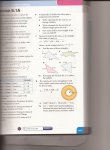Unfortunately I can't use latex yet so advanced apologies for messy notation:
heron's Formula: A = sqroot: s(s-a)(s-b)(s-c) where s =a=b+c/2 (semiperimeter)
So the question says : rearrange formula for A to make c the subject.
This is what I tried:
Remove sqroot: s^2 = s(s-a)(s-b)(s-c)
then s^2/S(s-a)(s-b) = s-c
then s^2/s(s-a)(s-b) -s = -c
then reverse signs: -s^2/s(s-a)(s-b) +s = c
I suspect I've messed this up-but my book doesn't have the answer for this so I can't check.
Any pointers to where I've gone wrong-gratefully received.
heron's Formula: A = sqroot: s(s-a)(s-b)(s-c) where s =a=b+c/2 (semiperimeter)
So the question says : rearrange formula for A to make c the subject.
This is what I tried:
Remove sqroot: s^2 = s(s-a)(s-b)(s-c)
then s^2/S(s-a)(s-b) = s-c
then s^2/s(s-a)(s-b) -s = -c
then reverse signs: -s^2/s(s-a)(s-b) +s = c
I suspect I've messed this up-but my book doesn't have the answer for this so I can't check.
Any pointers to where I've gone wrong-gratefully received.

